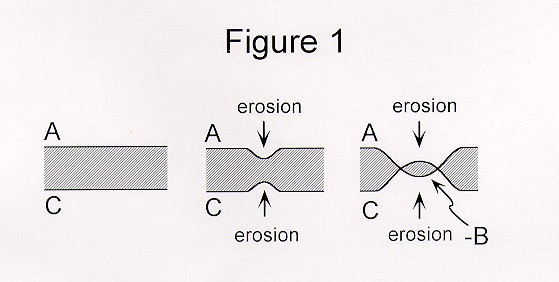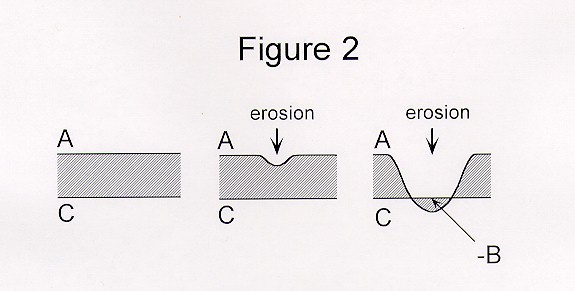Negative Isopach TheorySenteur de Boue
Equity negotiations associated with the recent sale of the U. S. Naval Petroleum Reserve at Elk Hills has brought to light several geologic contour maps with negative isopach values. Although a few of these undoubtedly represent drafting errors, many maps containing negative isopachs are computer generated and result from sophisticated software packages incapable of producing erroneous data. Nonetheless, because negative isopachs require the rocks in question to have negative thickness and volumes, some geologists of the old school reject this possibility. The enormous exploration and development potential of negative isopachs requires a closer examination of the problem and warrants a short discussion on negative isopach theory to clarify some common misconceptions. When contour maps indicate that an upper horizon is lower than a lower horizon and the lower horizon is not as low as the upper horizon, the thickness of the stratigraphic unit between the horizons is a negative number. Two simple processes account for most negative isopachs: 1. Bi-directional erosion - Negative thicknesses can develop when a unit is being eroded simultaneously (and at the same time) from both top and bottom, resulting in erosion surfaces from both directions that cross over to create a negative isopach value (Figure 1). Erosion from the top may be initiated by a variety of processes well known to anyone who has taken a basic sedimentology course. Erosion from the bottom can result from "karst-type" solution, massive-bio-turbation (i.e., mass-turbation), removal of material by worms, and continuing erosion by buried submarine channels. The later explanation appears to account for many negative isopachs in the southern San Joaquin Valley. In these cases, buried submarine channels, with high channel flow velocities resulting from turbidity currents, are buried by rapid sedimentation before the channel flow can dissipate. Consequently, the turbidity current continues to erode away at the bottom of the overlying unit. Whatever the cause of erosion, a unit with negative thickness must have sufficient plasticity and compressive strength to remain present after it is eroded away. 2. Ultra-high rates of erosion - If the top surface of a unit is eroded at excessive rates (above 47.3 m/yr) then this surface can pass through a stratigraphically lower surface without disturbing it (Figure 2). This erosional configuration resembles that of a 3-D Mobious Strip and takes place when the erosional process is eolian and the grain size of a buried basal unit, indicated as unit "C" in Figure 2, is very large. This allows wind to penetrate gravel in unit C and incise a buried surface at the -B to C interface without affecting boundary A to -B. Field confirmation of negative isopachs is difficult. Seismic exploration for these features is impossible because absorption of P-waves by areas of negative thickness results in no reflections. Gravity surveys may be useful if the negative rock mass within an erosional crossover is sufficiently large to not be seen. Finding negative isopachs in outcrop is extremely difficult because these areas cause rock hammers, Brunton compasses, and at times entire parties of field geologists to disappear. Despite problems of field confirmation, negative isopachs are economically appealing because of rock properties that include porosities and net-to-gross sandstone ratios greater than 1.0. For example, if a reservoir rock is saturated with oil, and total pore volume within the reservoir exceeds the volume of rock matrix, then the volume of oil exceeds the negative volume represented by the negative isopach. Thus, infinite production is possible. On the other hand, if the pores are fluid filled, negative volumes can accommodate disposal of an infinite amount of waste. Other applications can no doubt be imagined. The economic rewards of exploring for negative isopachs are balanced by difficulties in trying to penetrate them with the drill bit. Among the many drilling problems that must be contended with are negative drill rates and reverse mud circulation. Also, large amounts of core are required to fill well bores as intervals of negative thickness are "undrilled". Nonetheless, the vast potential of negative isopachs justifies much expenditure and effort to overcome these problems. If we can become proficient in locating, drilling, and exploiting negative isopachs in the southern San Joaquin basin, then the opportunity will finally be provided to discover some of those oil pools that we all know exist but have never been able to find.
|



